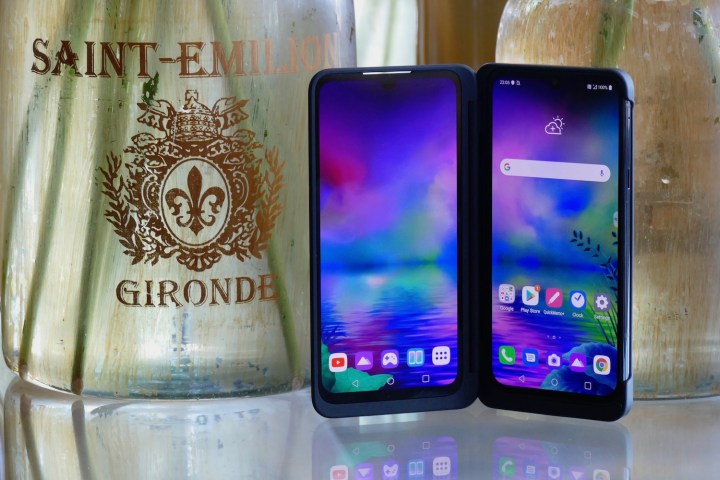
Two screens on a regular smartphone? That’s what LG’s G8X ThinQ Dual Screen is promising. It’s similar to the dual-screen attachment LG showed off at MWC 2019 on the V50 ThinQ, but there have been a lot of changes to improve this new version over the first, and it has made it a considerably more interesting solution to our modern multi-tasking woes.
But a dual-screen accessory isn’t the only new feature with the LG G8X ThinQ. From an ASMR mode to a 32-megapixel selfie camera, here’s everything you need to know about it.
The phone
The LG G8X ThinQ is a revised version of the LG G8, also released earlier this year. The design is identical, so it has a smooth, lightweight body that’s warm to the touch. It weighs 192 grams and is 8.8mm thick. On the front is a 6.4-inch OLED screen with a small teardrop notch at the top, and it has an FHD+ resolution. The screen also contains a fingerprint sensor, similar to Samsung’s Galaxy S10 range.

Inside is the Qualcomm Snapdragon 855 processor with 6GB of RAM, 128GB of storage space, plus a 4,000mAh battery with support for Quick Charge 4.0 for fast charging. The camera is the biggest alteration here over the LG G8, specifically on the front, as there is now a 32-megapixel camera with an f/1.4 aperture. On the back is a dual-lens system made up of a 12-megapixel main lens with optical image stabilization and a wide-angle lens with 13 megapixels. The main rear lens is the same, but the wide-angle has gone down in megapixel count from 16 on the LG G8.
Other features include a new stereo speaker system, a 32-bit Quad-DAC, wireless charging, and a MicroSD card slot. The phone is tough too, as it has both an IP68 rating for water and dust resistance, plus it complies with the MIL-STD-810G standard to withstand some rough treatment and extreme temperatures.
The Dual Screen case

Here’s where a lot of the key alterations have been made. The Dual Screen case now has a 6.4-inch OLED screen that’s the same size and specification as the main G8X ThinQ screen, for improved visuals. It no longer connects using Bluetooth, and instead has a USB Type-C connector inside the case, which means you no longer have any lag between the two screens.
It’s thinner at 14.9mm and lighter at 134 grams, and the screen consumes 10% less power too, but perhaps the best news is that the front panel has a small 2.1-inch OLED screen to show the time and notification icons, plus it can rotate freely all the way around the phone, rather than being set at specific angles. This makes it more versatile, while the screen ensures you don’t have to open the case just to check the time or notifications.
Software, ASMR, and dual-screen features
The G8X ThinQ uses a new version of LG’s own user interface, called LG UX 9.0. LG has listened to feedback and visually improved the software, with more space, bolder fonts, and grouped items for ease of use. There’s a new dark mode, plus many of the buttons have been shifted around to make one-handed use simpler.
More interestingly, the phone has an ASMR mode (Autonomous Sensory Meridian Response), so the powerful mics on-board can pick up the faintest of sounds clearly, ripe for your YouTube debut
There are also many special features for use with the dual-screen case, mostly centered around multi-tasking and gaming. You can instantly screen-capture the second screen to attach to a message or email, leave YouTube open for continuous streaming even when using another app, browse Instagram shopping links while still in Instagram, use the case in landscape so the lower screen is only a keyboard, and browse images from the gallery on both screens at the same time.
A custom gamepad mode lets you configure the lower screen to act as a touchscreen control system, making it like a Nintendo 3DS. LG’s working with Nvidia’s cloud gaming system now, and will work with Google’s Stadia in the future. This is just the beginning of what’s possible with the second-generation Dual Screen case on the LG G8X ThinQ.
Price and availability
How much would you pay for a dual-screen, flagship-spec phone? A lot less than you might have thought. Pre-orders for the LG G8X ThinQ will start on October 25, and will be available for sale from November 1. Prices for an unlocked LG G8X ThinQ with an LG Dual Screen will start at just $700. The phone will be available from several major carriers and retailers across the U.S., including Amazon, Sprint, and AT&T.
Updated on October 22, 2019: The LG G8X’s release date and price have been announced.
Editors' Recommendations
- Master your LG G8 ThinQ with these handy tips and tricks
- Best tech of IFA 2019: From OLED TVs to lightning-fast laptops
- Wave your hands if you want the powerful, yet more affordable LG G8S ThinQ



